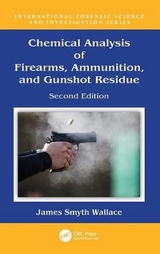
Chemical Analysis of Firearms, Ammunition, and Gunshot Residue
Crc Press Inc (Verlag)
978-1-4200-6966-2 (ISBN)
- Titel erscheint in neuer Auflage
- Artikel merken
Firearms and their associated ammunition, spent bullets, and spent cartridge cases provide useful information for identifying suspects, terrorist groups, and the criminal history of a weapon. Unfortunately, despite the numerous detailed books on the physical aspects of firearms, very little has been published on the chemical aspects, and what has been published is sparse and fragmented.
Compiling information from the available literature and supplementing gaps with private communications and personal observations and research, Chemical Analysis of Firearms, Ammunition, and Gunshot Residue summarizes the history of firearms and ammunition as it relates to the development of modern weapons. It details chemical aspects of forensic firearms casework with particular emphasis on the detection of gunshot residues (GSR) on a suspect’s skin and clothing surfaces.
Drawing on the extensive experience of the Northern Ireland Forensic Science Laboratory (NIFSL) which processed a large firearms caseload during the region’s recent violent past, this book records the statistics gathered and the scientific methods developed to meet the demands of law enforcement and courts of law. It describes the analysis and methodology developed to routinely examine samples from terrorist suspects for both firearms and explosives residues.
Providing crucial, hard-to-find data for forensic laboratories and forensic chemists with little or no prior knowledge of firearms, this seminal work presents a wide range of firearms chemistry information and outlines the creation of a statistical database to aid investigations.
Dr. James Smyth Wallace is a retired U.K. forensic scientist and a 25 year veteran of the Northern Ireland Forensic Science Laboratory. He is the author/co-author of 14 scientific papers, as well as a forensic science textbook. He is a member of the Forensic Science Society and retains an active interest in forensic chemistry, particularly in the area of trace evidence detection.
Introduction
Definitions
Historical Aspects of Firearms and Ammunition
History of Gunpowder
History of Ignition Systems
History of Bullets
History of Ammunition
History of Firearms
Chemical Aspects of Firearms and Ammunition
Cartridge Cases
Primer Cups (Caps)
Priming Compositions
Propellants
Projectiles
Complementary Ammunition Components
Caseless Ammunition
Blank Ammunition
Firearm Construction Materials
Firearm Discharge Residue
Firearm Discharge Residue Detection Techniques
Properties of Firearm Discharge Residue
Experimental
Objectives, Sampling Procedures, Instrumentation, and Conditions
Particle Classification Scheme
Casework Related Tests
Analysis of Ammunition
Ammunition Containing Mercury
Lead Free Ammunition
Suspect Processing Procedures
Firearm Discharge Residue Sampling Environment
Organic Components of Firearm Discharge Residue
Sampling of Skin and Clothing Surfaces for Firearm Discharge Residue
Development of a Method for Organic Firearm Discharge Residue Detection
Conclusion
Index
| Erscheint lt. Verlag | 1.11.2008 |
|---|---|
| Reihe/Serie | International Forensic Science and Investigation |
| Zusatzinfo | 8 Halftones, black and white; 59 Tables, black and white; 64 Illustrations, black and white |
| Verlagsort | Bosa Roca |
| Sprache | englisch |
| Maße | 156 x 235 mm |
| Gewicht | 590 g |
| Themenwelt | Naturwissenschaften ► Biologie |
| Recht / Steuern ► Strafrecht ► Kriminologie | |
| ISBN-10 | 1-4200-6966-7 / 1420069667 |
| ISBN-13 | 978-1-4200-6966-2 / 9781420069662 |
| Zustand | Neuware |
| Haben Sie eine Frage zum Produkt? |
aus dem Bereich



